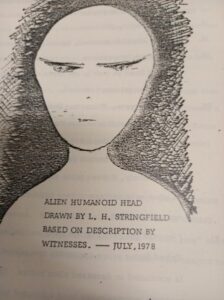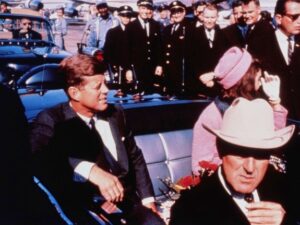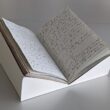Home University of Edinburgh Library Essentials
December 14, 2025
Pseudoscience and the supernatural: from phrenology and eugenics to ghosts, deceptions and mistakes, UFOs and conspiracy theories (Part 3)
Posted on August 17, 2023 | in Volunteers | by lbeattieAsh Mowat is one of our volunteers in the Civic Engagement Team. Ash has been looking into the relationship between pseudoscience and unexplained phenomena. In Part 1 of this blog post, Ash explores the science of pseudoscience and the papers of the Eugenics Society held in the University of Edinburgh Archives. In Part 2, he looks at a letter in the University Archives from Arthur Conan Doyle, describing ‘psychic disturbances’. In this final part, he looks at UFOs and some material in the archives about ‘retrievals of the third kind’.
UFOs and extra-terrestrials
It is perfectly reasonable to apply scientific processes to conclude that is likely or at least probable for there to be intelligent and technologically advanced life elsewhere in the universe, even if we have as yet no evidence of even microbiological life outside of our own planet.
NASA research starting with an estimated of some 300 million potentially habitable planets in our galaxy, is using the Kepler telescope to filter through these. Some 2800 exoplanets have been identified, and by using the Drake equation a few hundred possible earth like planets calculated to have better potential for facilitating the development of intelligent life and scope for technological advances. [1]

(Image above from https://www.newyorker.com/magazine/2021/05/10/how-the-pentagon-started-taking-ufos-seriously )
The problems posed to any communication with, let alone a visitation from, any alien life out there is complicated by issues of distance and timelines. The very nearest located potential earth like planet in over 30 light years away, and most of them farther still. Current technology and known physics prevent travel of such distances. The lightweight unmanned NASA vehicle Voyager travels at tens of thousands of miles per hour yet would still take tens of thousands of years to make such a journey. [2] Even if a piloted ship could travel at such a speed, how vast must the crew and vehicle be to avoid inbred genetic collapse over such long a time, where would all the food fuel and water come from, and what physical and psychological harms would be suffered by any such crew living their entire life on a cramped spaceship in the depths of space. Werner Herzog’s faux documentary film the Wild Blue Yonder explores some of these conflicts in an entertaining and provoking piece of art.
Aliens or indeed humans may develop better travelling technologies, but one other barrier are timelines not matching between distant worlds. Our earth is some 4.5 billion years old, yet modern humans first emerged out of Africa around 70,000 years ago. Further, we’ve only had the ability to send radio waves and later vehicles into space for some decades. Other planets may have intelligent life and technology but only for periods of time that precede or come after our own.
Perhaps the most likely, if still improbable, communication from another planet may be detected as a radio signal via NASA SETI project, and not in an actual visit to our earth by some hopefully benign aliens. Sadly, even were such a signal received it would be so old in origin as not to permit a response to a civilisation and planted that may now be dead and gone.
To assert that UFOs have actually visited our planet is another matter, and one that requires serious evidence.
A visit to the University of Edinburgh archives on UFOs
I visited the library to view ‘Retrievals of the third kind: a case study in alleged UFO’S and occupants by military history, dated 1978’. [3]
The case study itself was forwarded with a covering letter to the then Prime Minister of Canada, the letter sent from Andrew Michrowski. The letter proposes consideration to establish a global scientific group to be established to investigate all reported UFO, and devolve this from a military jurisdiction over allegations of secrecy. The letter boldly declares “there is a vast number of scientists and technical persons (probably in the tens of thousands) who either have had contact with UFO phenomena, or who have been able to come out convinced of their existence”. There is no supporting evidence of this level of scientific belief in UFOs either in the letter or case study.
The letter also reports the former United Nations secretary general Mr U Thant to have publicly stated “aside from the proper redistribution of food, the UFOs present the most important problem in the world”.
The case study itself was written by Leonard H Stringfield, a published author on UFO events. In it he outlines that those involved in UFO research mainly adopt one of two positions as to what they are, either they’re a psychical or parapsychal event, or alternatively they are an actual visitation from an alien race with the advanced technology to develop vehicles that can make the immense journeys required to reach us. The author of the case study favours the latter. He misuses, at least in the scientific sense, the word theory: “there are many other provocative splinter theories…theories are free and a dime a dozen”. That might be a harsh observation to make, as theory is used more loosely in general conversation, nevertheless this is from someone calling for scientific research.
He refers to around 13 thousand reports of alleged UFO’S held with air force base in Washington but available for the public to study. Air force base established “project blue book” in 1957 to specifically investigate reports of UFOs. It closed in 1969 during when they concluded “nothing has come from the study of UFOs in the past 21 years that has added to scientific knowledge.” [4]
There was a flurry of public interest in UFOs in the USA in the 1950s[5], the period focused on in these case studies. Interest had waned in the 1960s, perhaps because of the interest from the developments in US and USSR manned space travel missions. However, the year before this case study was written, the blockbuster movie Close Encounters of the Third Kind, had been released and rekindled interest in UFOs.
The 22 examples in the case study are termed “retrieval of the third kind”, a term coined by its author to mean examples when crashed alien spacecraft were found and taken into storage by US military, often with the bodies of aliens themselves that had died in the incidents. The cases all focus on the US military in terms of witnesses, and occur in remote desert areas often near military bases. The author is suspicious of a conspiracy of silence “we must also take a new look at the possibility of a grand official cover up”. He includes the military, secret service agents, and the media of being involved in this.
Before detailing his twenty or so alleged incidents he states “I cannot refute the credibility of any of my informants”, but also “I do not possess single affidavit to prove that any one of my informants has seen a retrieved craft or its occupants. I only have their testimony.”
All the testimonies are quite short and quite loosely detailed. They often share a lot of similarities, for example the space crafts are widely described as metallic, something like aluminium, and about 30 feet in length. The aliens themselves are commonly recorded as being of small stature, between 4 to 5 feet tall. Similarity could indicate consistency, but equally it could be suggest copycat reporting, or the influence of images of UFOs and aliens in popular science fiction books, television or movies.
The testimonies are a mixture of anonymous and named individuals, often employed or connected with the military. They all report senior staff firmly warning all witnesses to remain entirely silent. Craft and, where discovered, alien bodies, were removed and placed into storage in US army bases, one testimonial citing that up to 30 aliens were held from various crash episodes. The author includes two rudimentary drawings (see below) he made of an alien face and hand, based on a description given to him by one of the witnesses of an alleged encounter with one.


There’s a lack of independent witnesses, i.e. members of the public. There’s a description of film footage taken of an alien craft, but no film itself, no photographs, no physical evidence provided of any UFO’S or their occupants. That lack of proof does, of course, fit with the author’s stance of a conspiracy of secrecy and cover ups.
Ultimately, I’m reminded of the quote by the late, great cosmologist Carl Sagan[6]: “extraordinary claims require extraordinary evidence”. It seems, to me at least, that for then and know, the UFO and alien visitations to earth are best confined and enjoyed within the realms of science fiction.
Conspiracy theories
Conspiracy theories purport to identify and expose instances such as when powerful people, governments or institutions, abuse power, exert harm, and evade punishment (my definition). Sometimes genuine conspiracies do occur, consider the decades of the tobacco industry burying and suppressing evidence of the medical harm of cigarettes in an effort to evade responsibility and retain their profits.[7] Or equally actions by the Catholic and other churches to deny the existence of child sexual abuse and to protect rather that report perpetrators.
The term conspiracy theory now mostly alludes to improbable events that overlook evidence that refutes them.[8]
As an example, I was brought up to believe in an early and popular example, that JFK was not assassinated by Lee Harvey Oswald alone or at all, but that he was a victim of an internal US political conspiracy to end his presidency due to his liberal views on racial equality and wishes to have dialogue with opposing Communist Russia and end the Vietnam war. [9]
Such conspiracy theories can be a form of comfort or escapism, where it is harsh and hard to accept that in a random act, a lone and unspectacular individual killed a person of power, influence and renown. There can be a desire to import that some wider actors and influences must have been involved, to make sense of such a national loss. (Not that JFKs personal, political or pioneering legacy has uniformly lived up in biographies and testimonies, but that’s another subject well explored elsewhere).
My perhaps biased and certainly uninformed beliefs in this area were further instilled after watching Oliver Stone’s JFK movie in 1991. This film presented a dizzying array of plots involving the CIA, the mafia, anti- Castro Cuban groups, and revealed a colourful array of likely involved assassin cohorts. It’s a very entertaining movie, mostly due to the performances, but since I’ve read further into the crime, I now totally accept the view that the film is entirely bogus, harmful as false history, befuddled with implausible nonsense, and of the opinion that Lee Harvey Oswald alone killed JFK and was not connected with any others in a conspiracy to do so.

(Image above from https://fivethirtyeight.com/features/the-one-thing-in-politics-most-americans-believe-in-jfk-conspiracies/ )
Two books in particular, American Grotesque by James Kirkwood (1970) and Case Closed by Gerald Posner (1993) convinced me, at least, to accept Oswald acted alone. Firstly, the premise of all the conspiracy theories seem wholly implausible (how many hundreds or thousands of people would have to be involved in and stay silent on an event involving US Government, the Mafia, ballistic and other investigators, the majority of the actual crime witnesses, hospital and autopsy staff etc.).
Secondly, the investigator Jim Garrison who took the conspiracy case to the US courts, was exposed in both these books to have been unprofessional in dealing with often unreliable and prejudiced witnesses, in poorly asserting evidence, bias towards members of the gay community, and prone to personal grandeur and paranoia. Case Closed also meticulously, at least to me, dismisses all evidence beyond reasonable doubt that Oswald alone committed the murder, eliminating convoluted preposterous plots and distilling the facts forensically.
This is my view. Clearly, I have not seen or ready anything like all the evidence on all sides on the JFK killing, therefore it’s entirely valid for others to still pursue and doubt the official findings of the case.
More recently, Covid virus origins and related issues such as Government responses and vaccine and other interventions have become rife. The tone and views expressed in Covid debates can themselves illustrate the bridge between genuine scepticism and concerns, aside from the more unhinged and unfounded discussions. For example, Covid vaccine pioneer Dame Sarah Gilbert, has correctly asserted the right to question scientific progress without by doing so being necessarily irrational or deluded.[10]
For example, some people question the safety and long-term efficacy of Covid vaccines, given how rapidly these were developed and deployed. To have such doubts is not evidence of uninformed thinking, as with HIV and AIDS we’re yet to have a vaccine after over 40 years (although fortunately we’ve an effective virus suppressing treatment). Distinct from such rational questioning, beliefs in a laboratory created virus deliberately spread and endorsed by Bill Gates or others, deserve neither serious attention nor credence. Worse still are the grotesque and deeply damaging conspiracy theories denying School Shootings or terrorist events despite overwhelming evidence of their occurrence, often monetising for the purveyors of such lies, and always an appalling insult to the victims and families affected.
Finally, I’d like to end on an entirely personal view on debating opposing views with others. Personally, I love to converse with those whose opinions differ from mine, and indeed relish when a point I’d not considered is raised and I consequently revise my position.
There are two categories of debate, however, that I’m reluctant to engage in: the hateful and the ludicrous. The hateful includes white supremacists and holocaust deniers, the ludicrous flat earth society believers. It can prove a draining and damaging pursuit to be exposed to discussions with such fervent believers of nonsense, especially where confronting someone wholly indisposed to change their mind. That said, we’ve a collective duty as people to always inform and educate always against all mistruths, and happily there are experts and journalist dedicated and equipped to help inform and re-educate people, who may have been groomed by others into adopting such beliefs.
[1] https://www.seti.org/press-release/how-many-habitable-planets-are-out-there (accessed 3.1.2023)
[2] https://voyager.jpl.nasa.gov/mission/status/ (accessed 2.1.2023)
[3] https://archives.collections.ed.ac.uk/repositories/2/archival_objects/66302 (accessed 5.1.2023)
[4] https://en.m.wikipedia.org/wiki/Project_Blue_Book (accessed 4.1.2023)
[5] https://www.bbc.com/culture/article/20220714-the-ufo-sightings-that-swept-the-us (accessed 4.1.2023)
[6] https://en.m.wikipedia.org/wiki/Sagan_standard (accessed 5.1.23)
[7] https://en.m.wikipedia.org/wiki/Tobacco_Master_Settlement_Agreement (accessed 5.1.2023)
[8] https://en.m.wikipedia.org/wiki/Conspiracy_theory (accessed 4,1,2023)
[9] https://en.m.wikipedia.org/wiki/John_F._Kennedy_assassination_conspiracy_theories (accessed 4.1.2023)
[10] https://www.google.com/amp/s/amp.theguardian.com/society/2022/jun/26/vaccinologist-sarah-gilbert-vaxxers-astrazeneca-we-need-to-be-better-prepared-for-a-new-pandemic (accessed 6.1.2023)
Collections
 Hill and Adamson Collection: an insight into Edinburgh’s past
My name is Phoebe Kirkland, I am an MSc East Asian Studies student, and for...
Hill and Adamson Collection: an insight into Edinburgh’s past
My name is Phoebe Kirkland, I am an MSc East Asian Studies student, and for...
 Cataloguing the private papers of Archibald Hunter Campbell: A Journey Through Correspondence
My name is Pauline Vincent, I am a student in my last year of a...
Cataloguing the private papers of Archibald Hunter Campbell: A Journey Through Correspondence
My name is Pauline Vincent, I am a student in my last year of a...
Projects
 Cataloguing the private papers of Archibald Hunter Campbell: A Journey Through Correspondence
My name is Pauline Vincent, I am a student in my last year of a...
Cataloguing the private papers of Archibald Hunter Campbell: A Journey Through Correspondence
My name is Pauline Vincent, I am a student in my last year of a...
 Archival Provenance Research Project: Lishan’s Experience
Presentation My name is Lishan Zou, I am a fourth year History and Politics student....
Archival Provenance Research Project: Lishan’s Experience
Presentation My name is Lishan Zou, I am a fourth year History and Politics student....

